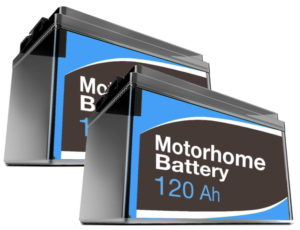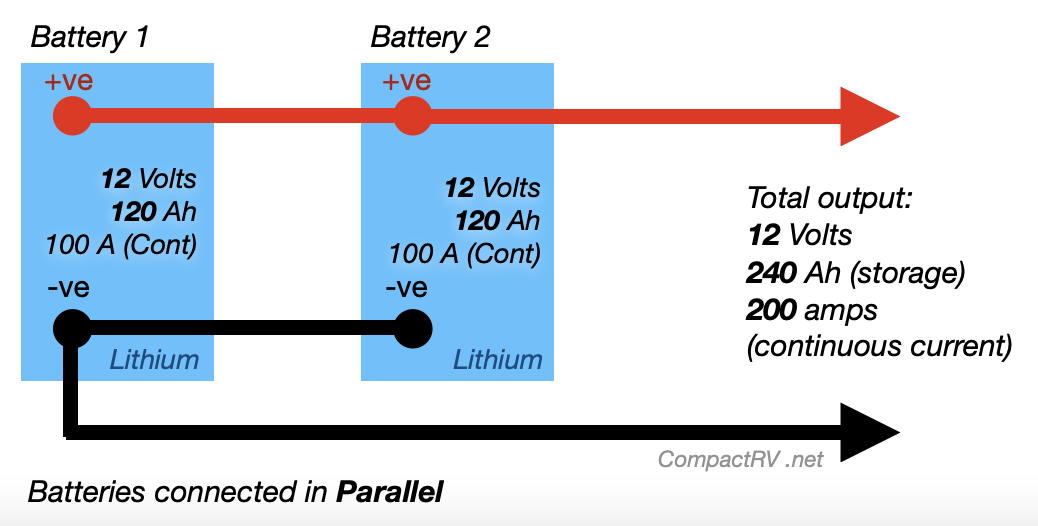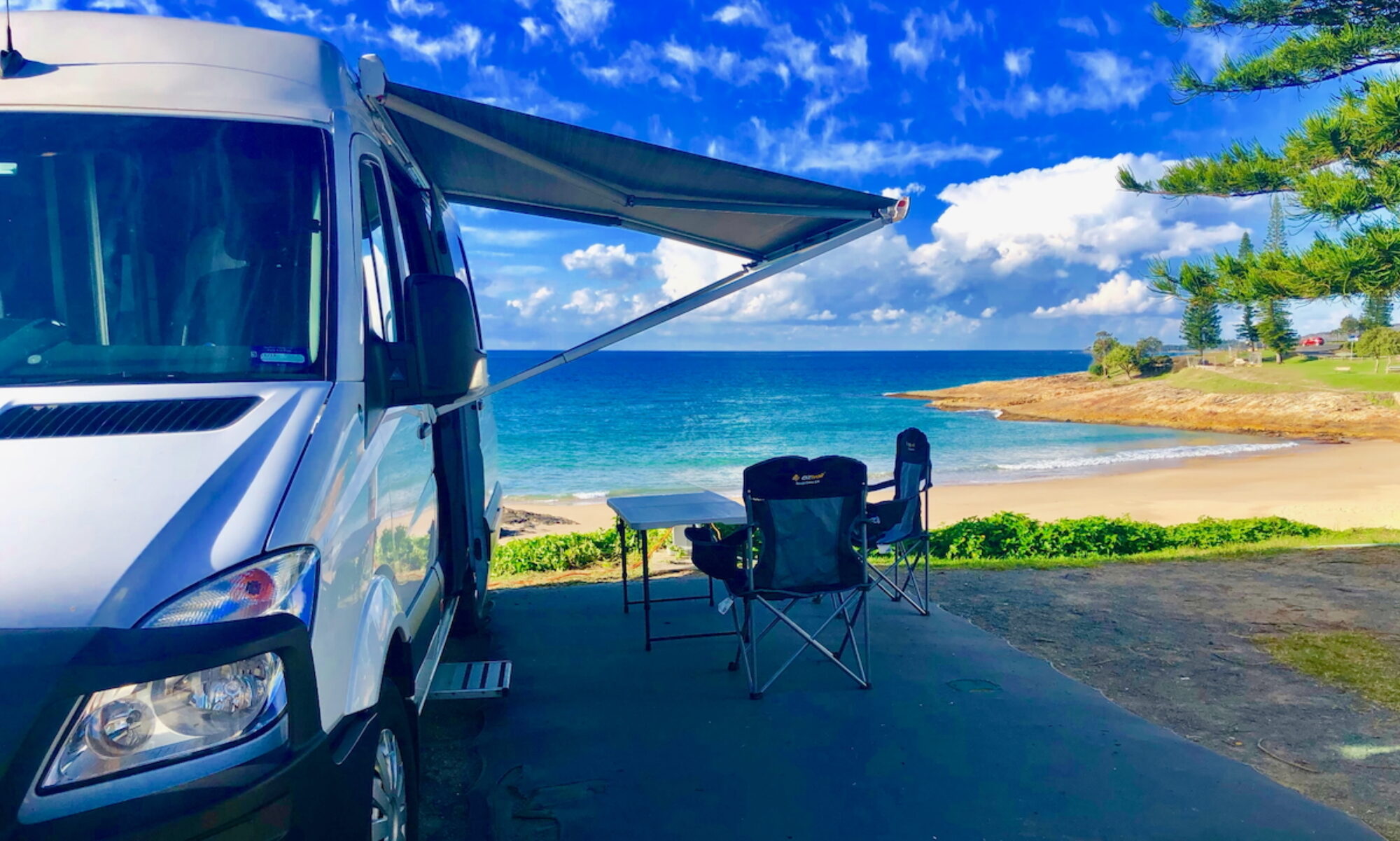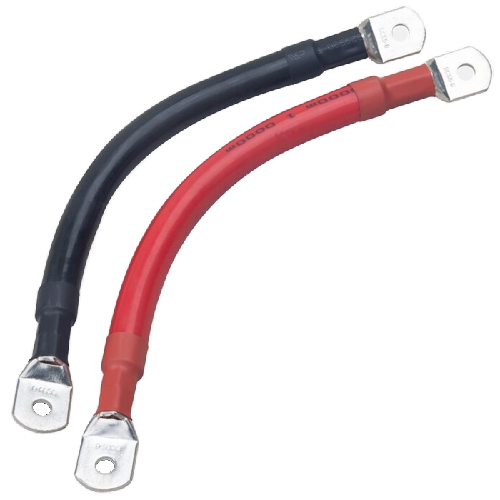Sustainability: Batteries & Solar | Water | Heating
Batteries | Consumption | Battery Recharging | Solar Charging | How Long Without Sun? | Alternate Charging Options | The Bottom Line
The Parallel Universe
 Campervans and Motorhomes often have multiple batteries connected ‘in parallel’ to increase 12V electrical storage capacity.
Campervans and Motorhomes often have multiple batteries connected ‘in parallel’ to increase 12V electrical storage capacity.
Two 12V batteries, each with with 120Ah capacity, connected in parallel will provide 240 Ah of storage capacity at 12V. As battery technology and manufacturing evolves much larger batteries are being connected in parallel ….
-
- 200Ah + 200Ah = 400Ah capacity
- 300Ah + 300Ah = 600Ah capacity
The continuous current (continuous discharge) available from batteries connected in parallel will also be nearly double that available from each battery. This is of particular interest to those with Lithium batteries and a power inverter.
Alternatively, two 12V batteries can be connected ‘in seres’ (end to end) to increase voltage to 24V. This does not provide any increase in storage capacity, but it will result in appliances using less current (Amps = Watts/Volts).
Parallel connection: Connecting two batteries together ‘in parallel’ maintains the individual voltage of each battery as the combined voltage output (ie 12Volts) while doubling the overall storage capacity (Ah) of the individual batteries (120Ah + 120Ah = 240Ah). The +ve terminals of each battery are connected to each other, as are the -ve terminals ….

This parallel connection will also cumulatively increase the available continuous discharge current. Two LifePO4 (Lithium) batteries, each with a potential for 100 Amps continuous discharge, when connected in parallel will be able to supply a continuous 200 Amps output. (Check the specs of your particular batteries if continuous current is important.)
The maximum continuous current discharge rate is a critical factor if you will be operating power-hungry 230V AC domestic appliances through a power inverter. (AGM batteries’ maximum continuous discharge rate is around 30 amps per battery.)
| Getting Connected | ||
|
This avoids the charge of the cells in one battery (the battery closest to the output terminals) being depleted at a greater rate than the other battery. Ditto for recharging. For maximum efficiency and life-cycle longevity, 12V batteries connected in parallel must be of the same age and storage capacity. Ideally from the same manufacturing batch. Be sure to use suitable heavy gauge cabling when connecting the batteries.
|
Series connection: Connecting two batteries together ‘in series’ (end to end, +ve to -ve), combines the individual voltage of each battery to double the overall voltage output (ie 12V + 12V = 24V) while maintaining the overall storage capacity (Ah) of each individual battery (eg 120Ah).
For maximum efficiency and life-cycle longevity, 12V batteries connected in series must be of the same age and storage capacity.

The current consumed by appliances decreases as the voltage increases. So where a 12V fridge consumes current at the rate of 3 amps per hour, a 24V fridge may only be consuming 1.5 amps per hour. This is calculated using the formula P=VI. (Power = Voltage x Current)
-
- See also: Installing an inverter in our Campervan
Important
Charge each battery on a 230V charger overnight, then allow the batteries to ‘rest’ for 5 hours to ‘settle’ the charge. Then connect together. |
Note: It is possible to connect more than two batteries in series or parallel. This is very much dependent, particularly with Lithium batteries, on the technical specifications of the batteries, and their internal battery management system (BMS). Check with the battery manufacturer / supplier.
Batteries | Consumption | Battery Recharging | Solar Charging | How Long Without Sun? | Alternate Charging Options | The Bottom Line

 The output cabling of two batteries connected in parallel should be taken ‘diagonally’ (+ve from one battery, -ve from the other) to maintain load balancing across the batteries. (See cabling diagram above).
The output cabling of two batteries connected in parallel should be taken ‘diagonally’ (+ve from one battery, -ve from the other) to maintain load balancing across the batteries. (See cabling diagram above).